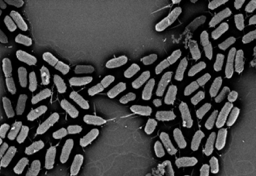
01 Apr Why do we need so many different collections of E. coli?
Public microbe collections acquire, characterize, preserve and distribute strains for research. There are several public collections of the bacteria E. coli, because it is both an important model organism for studying cellular functions, and because it is an environmental species that impacts human and animal health. Collections of E. coli in the U.S. have similar names, and similar holdings, but different uses.
The E. Coli Genetic Stock Center (CGSC) at Yale University (https://cgsc.biology.yale.edu/) contains 12,000 strains, primarily genetically modified strains of E. coli, most derived from lab strain K-12. Strains are used for research in medicine, microbiology, biochemistry, chemical engineering, biotechnology, cell biology, genetics, pharmacology, agriculture, physics, and much more.
The E. coli Reference Collection (STEC) at Michigan State University (https://mgi.natsci.msu.edu/labs/manning-lab/stec-center/index.aspx) contains >16,000 strains from patients with infections, livestock and environmental sources as well as genetically modified strains of different E. coli isolates. These collections are used in studies of whole genome phylogeny, animal health, animal gut microbiome, and food safety.
The E. Coli Reference Center (ECRC) at Pennsylvania State University (https://foodscience.psu.edu/research/centers/ecoli/services) contains 90,000 strains of wild-type, non-genetically modified E. coli isolated from humans, food, environment including soil and waterways, and other habitats. The genomes of about 4,000 of these strains have been fully sequenced. Strains with specific properties are used by academic and government agency researchers for many different studies. Some recent examples:
- Porcine enterotoxigenic E. coli strains, which cause diarrhea in piglets; for vaccine development
- Shiga toxin-producing strains for commercial assay development
- Sets for developing bacteriophage therapies
- Strains that carry the pks gene cluster, which is associated with colon cancer
ECRC is one of the few laboratories that performs agglutination-based serotyping, because it requires maintaining antibodies for over 180 O-groups. They also perform PCR screens for customers to assess potential virulence of isolates. They are also leading a panel to coordinate serogroups identified by the traditional method with genome sequence data.
From Ed Dudley, director of ECRC: “Some notable things we’ve done recently – We participated with a vaccine company in a multi-year study identifying the O groups for E. coli most associated with septic diseases among geriatric populations, and we worked with ThermoFisher to help them develop a DNA-based method of identifying O groups by sequencing. We also lead an international group (https://sites.psu.edu/ecolishigella/ ) to identify and name new E. coli O types identified by large sequencing efforts, and to propose the merging of E. coli and Shigella into a single genus.”
QUESTION: We have heard of E. coli O157:H7, a strain that is a foodborne pathogen that causes severe diarrhea. What do those numbers mean?
ANSWER: For nearly 80 years, E. coli strains have been distinguished by agglutination-based serotyping, meaning ability to bind to antibodies to slightly different antigens in the lipopolysaccharide (O group), capsule (K group) or flagella (H group). There are 187 different O groups, 53 different H groups, and 60 K groups. So, the infamous foodborne pathogen strain of E. coli has O antigen number 157 in its lipopolysaccharide, and H antigen number 7 in its flagellum. Only a few labs in the world still maintain the hundreds of different antibodies needed to run the traditional panel of tests, and one of them is the E. coli Reference Center at Penn State. ECRC is leading efforts to standardize the numbering of these groups.
By:
Kyria Boundy-Mills, Curator, Phaff Yeast Culture Collection (UCDFST), University of California Davis
Edward Dudley, Director, E. Coli Reference Center (ECRC), Pennsylvania State University
Shannon Manning, Associate Professor, E. Coli Reference Collection (STEC), Michigan State University
John Wertz, Curator, E. coli Genetic Stock Center (CGSC), Yale University
Sources:
https://sites.psu.edu/ecolishigella/
https://www.ifsh.iit.edu/sites/ifsh/files/departments/Edward_Dudley_HTS_2018.pdf
